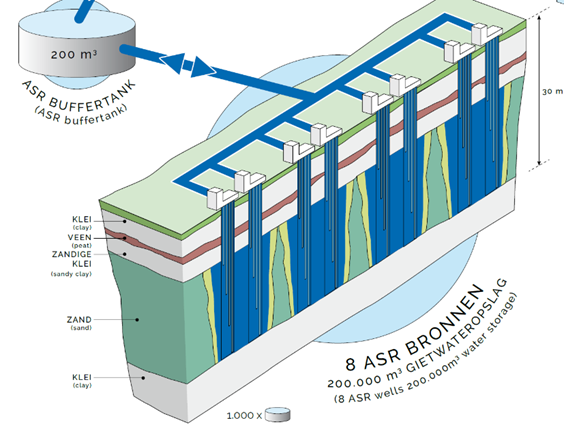Digital Twin for the development of data and model to support ASR management systems
Subsurface water storage, also known as Aquifer Storage and Recovery (ASR), of excess freshwater can play an important role in enhancing the sustainability of water use in the agricultural, industrial and drinking water sectors.
In contrast to the situation with traditional reservoirs for water storage, such as drinking water tanks and rainwater basins, ASR system users do not at present have a good sense of how much suitable freshwater is still available for recovery. As a result, the systems are frequently used sub-optimally, and one can for example unexpectedly run out of supplies or even infiltrate unnecessarily large volumes of water, which results in extra costs. There are therefore efficiency gains to be made through the development of tools to improve the management of ASR systems.
Technology
Groundwater models are traditionally only used during the design phase of an ASR project, and thereafter only on a sporadic basis when problems arise or modifications are planned in the system. For the users of ASR systems, these models therefore cannot be used to assess the current situation in the subsurface, and determine the volume of freshwater still available for recovery. In order to provide such knowledge, in this digital twin project, for the first time, a set-up for such a management system will be developed, in with the results of the model calculations will be presented in combination with information from actual measurement data. This will provide the clearest possible picture of the current and future situation of the freshwater supply, based on different future management scenarios.

Challenge
This project will develop groundwater models which will be frequently and automatically updated on the basis of the latest field data. The models will then be run to produce new estimates of the development of the subsurface freshwater lens under different management scenarios. Besides the traditional physical groundwater models, this research will also study several other indicators of the performance of the participating ASR systems, such as time series analyses of field measurement data based on machine learning techniques. The predictions made and the field data will then be visualised and presented on an online dashboard, which should enable the end-user to make better management decisions.
Solution
The ‘digital twin’ study should constitute a proof-of-concept for informing users of ASR systems to enable strategic management decisions: an online dashboard on which the most updated field data are presented, but also the estimated current extension of the freshwater lens, based on model calculations, and a prediction of the volume of recoverable suitable freshwater. Such data- and model-driven management tools can contribute to a more efficient management of ASR systems and, therefore, to more sustainable water use.